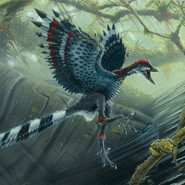Posted 14 APRIL 2009
Dinosaurs may have evolved wings to impress breeding mates
For decades scientists have debated the controversial subject of why dinosaurs evolved the ability to fly. Several theories have been suggested including one which claims that these "proto-birds" flapped their forelimbs like wings to give them additional thrust to climb while escaping from predators, and another which describes wings as evolving to help dinosaurs jump out of trees and glide to the ground.
But the co-authors of a new scientific paper published in the journal Evolution suggest that neither of these theories offer enough reason of ‘competitive advantage’ for wings to develop among dinosaurs by means of natural selection.
The scientists from Manchester University and University College Dublin propose that wings became more common and more pronounced through dinosaur generations because they helped to impress the opposite sex and to better attract breeding mates.
Image courtesy of Todd Marshall
Dr Robert Nudds, a biologist from the University of Manchester, worked with Dr Gareth Dyke, a paleontologist from the UCD School of Biology and Environmental Science at University College Dublin, to develop biomechanical models that could simulate the way Archaeopteryx, and two other feathered dinosaurs, Caudipteryx and Protarchaeopteryx, would have moved.
“According to our models, the two previous theories to describe why dinosaurs evolved wings do not give wing development enough competitive advantage to ensure that wings would have developed through natural selection.”
“If the animals were tree dwellers they would naturally have held out their forelimbs symmetrically, as they jumped from branch to branch or from ground to branch. If they were ground dwellers, which the fossil record suggests is more likely, holding the forelimbs out symmetrically would impede progress while running or moving along the ground. So we propose another driving factor for the evolution of wings – sexual selection.”
Once this unique style of motion had evolved, the evolution of flight was likely to have been a relatively straightforward process. "Only certain combinations of wing movement and forward speed are effective in producing the thrust required to propel an animal into the air, but our calculations indicate that even moderate wing movements are enough."
This implies that flapping flight could have evolved from a series of gradual changes in wing shape and movement, and did not necessarily require a large-scale shift.
According to the scientists, feathers, also, need not necessarily have evolved for the purpose of flight. As modified scales, they might have provided insulation or have been part of the mating game. "Feathered forelimbs may have been used in a ritual mating display."
The next stage for the scientific researchers is to use computer modeling to simulate how the animals would have moved or to build tiny mechanical models to look at the cost and benefits of each forelimb position.

